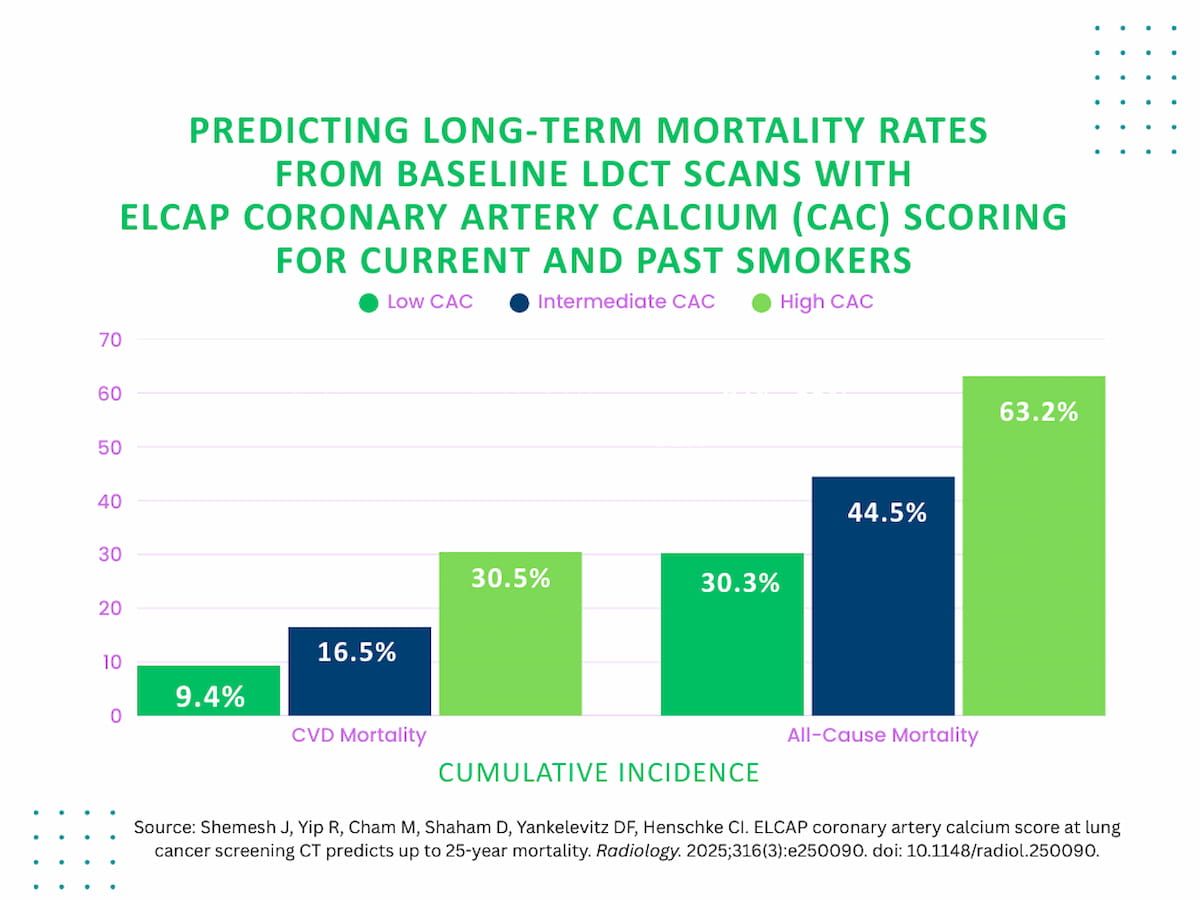Coronary artery calcium (CAC) scoring derived from non-gated low-dose computed tomography (LDCT) scans demonstrates significant capability for predicting long-term cardiovascular mortality, according to a new study involving over 8,700 participants.
For the prospective study, recently published in Radiology, researchers reviewed Early Lung and Cardiac Action Program (ELCAP) CAC scoring for 8,782 participants who underwent LDCT screening between 2000 and 2004. The cohort was comprised of current and former smokers between the ages of 40-85, and there was a median follow-up period of 22.6 years, according to the study.
The researchers found that the cumulative incidence of cardiovascular disease (CVD) death for those with high-risk CAC scoring (4-12) was 30.5 percent in comparison to 16.5 percent for participants with intermediate risk CAC scoring (1-3) and 9.4 percent for people with low-risk CAC scoring (0).
High-risk ELCAP-CAC scoring on baseline low-dose CT scans was associated with significantly higher cardiovascular disease mortality and all-cause mortality, according to a new study involving over 8,700 current and past smokers with a median follow-up period of 22.6 years.
Cumulative all-cause mortality incidence was 63.2 percent for those with high-risk CAC scores, 44.5 percent for cohort participants with intermediate-risk CAC scoring and 30.3 percent for people with low-risk CAC scores, according to the study authors.
The study authors pointed out that adjusted multivariable analysis revealed that high ELCAP-CAC scoring was associated with nearly double the risk of CVD mortality and over a 2.8-fold higher risk of all-cause mortality in contrast to low ELCAP-CAC scoring.
“Our findings show that a single ELCAP-CAC score at LDCT is a powerful long-term predictor of CVD death (hazard ratio, 1.98), while also confirming the prognostic value of absent CAC. Our study brings to light the potential for combining early detection of CVD and lung cancer, which are the top causes of death in the United States,” wrote lead study author Joseph Shemesh, M.D., who is affiliated with the Department of Cardiology at Sheba Medical Center in Ramat Gan, Israel, and colleagues.
Three Key Takeaways
- CAC scoring from non-gated LDCT strongly predicts long-term cardiovascular and all-cause mortality. High-risk scores nearly doubled CVD death risk and nearly tripled all-cause mortality compared to low CAC scores.
- Absent CAC on LDCT confers favorable long-term prognosis. This reinforces the prognostic value of CAC scoring even in a high-risk cohort of current and former smokers.
- Integrating CAC scoring into lung cancer screening programs may enhance preventive care. This could provide additive risk stratification beyond traditional methods and supporting its use as a potential public health measure.
Emphasizing the additive benefit with chest CT screening for lung cancer in current and past smokers, the researchers posited that CAC scoring can significantly enhance risk stratification beyond traditional laboratory-based methods for evaluating the potential for CVD.
“Given the risk stratification afforded by ELCAP-CAC scoring, it becomes even more urgent that CAC scoring be acted on in the context of a screening program and perhaps even as a public health measure,” implored Shemesh and colleagues.
(Editor’s note: For related content, see “CT-Based Coronary Artery Calcium Score Helps Predict Post-Op Survival Risks in Elderly Lung Cancer Patients,” “Computed Tomography Study Examines Potential of Automated Coronary Artery Calcium Scoring with Deep Learning” and “Study Says CT Scan is More Predictive than Genetic Risk Factors for Coronary Heart Disease Risk.”)
In regard to study limitations, the authors noted that subtle calcifications may have been missed with thicker section thickness thresholds (up to 5 mm) in older image acquisition with LDCT. Not only could this have led to misclassification of participants having an ELCAP-CAC of zero, but the researchers conceded the potential impact in reducing the predictive value associated with higher ELCAP-CAC scores.







